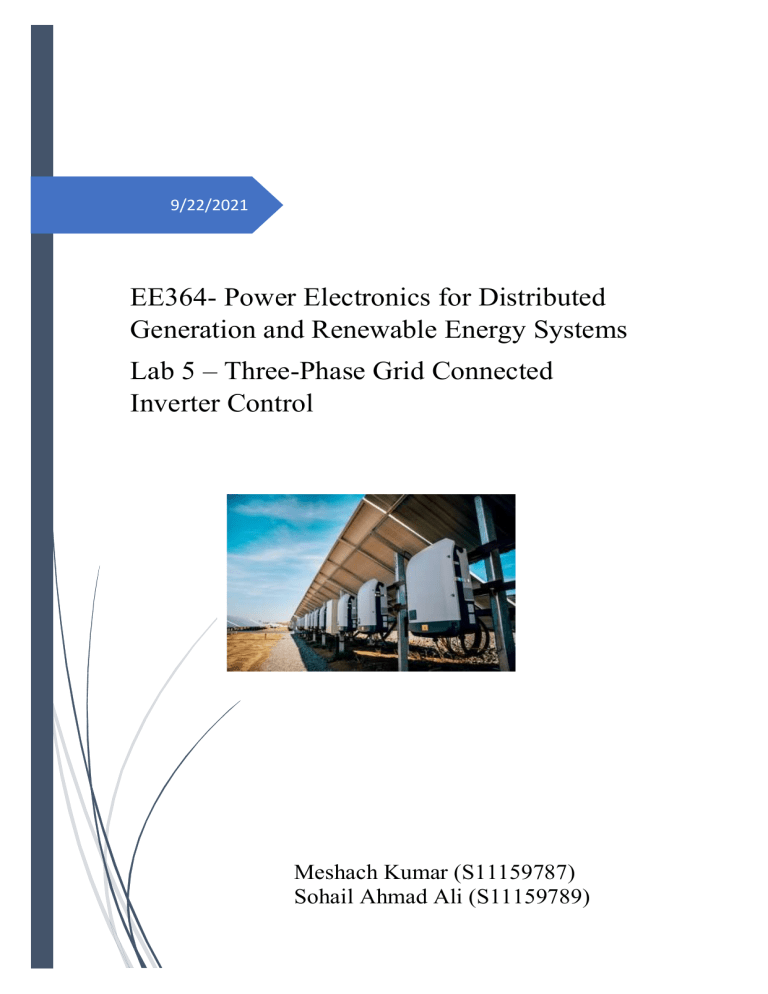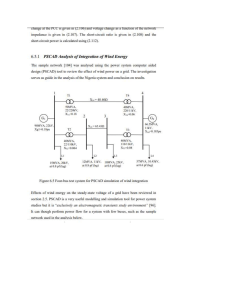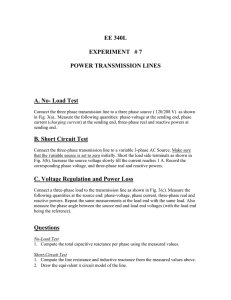
9/22/2021 EE364- Power Electronics for Distributed Generation and Renewable Energy Systems Lab 5 – Three-Phase Grid Connected Inverter Control Meshach Kumar (S11159787) Sohail Ahmad Ali (S11159789) Aim: The main aim of this lab is to implement a grid-connected system to supply at least 25kW power. Objectives: Implement Grid connected Inverter Implement DSOGI-PLL Implement the D-Q current controller Generate SPWM for inverter switching Introduction: Voltage source inverters are regarded as one of the important devices in situations where renewable energy sources are integrated into the grid and also controlling the injection of active and reactive power [1]. When looking at traditional power grids it is depended on centralized generation. However, in current times smart grids have been developed which include several distributed generation (DG) in its architecture. These units simply include the different renewable energy sources. And as time goes by there is an increase in integration of renewable energy sources and this leads to poor power system stability and affects the frequency and grid voltage [2]. Finally, to improve system stability and to effectively utilize DG units with seamless transition between islanded and grid-connected modes and not affecting the grid voltage and frequency, design of advanced control methods for the inverter devices that integrate DG systems to the main grid is of major importance [3]. Methodology: The control scheme used was active and reactive power control. This scheme is based on d-q axis voltage and current loop controls whereby by the three-phase output is used to develop the SPWM signals for inverter switching. Figure 1: Synchronous reference frame control of three phase inverter. The figure above shows the general inverter control system structure. The voltage and current are measured at PCC then converted to d-q reference frame. In our case the DSOGI-PLL is used to synchronize the grid at 50Hz and extract the phase which used in abc to d-q transformation. Later these values are subjected to the control scheme. The d-q current is compared to the reference value which is determined by the reference power. From the control scheme three-phase voltage is achieved which becomes the input to each dead-time circuit implemented in our model thus generating SPWM [4]. Figure 2: D-Q axis based current controller. The PI controllers are tuned using the Control System Designer APP based on the given TF: G(s) = 1 0.005𝑠 + 0.25 Results: Figure 3: Three-phase voltage waveforms at PCC. Figure 4: Three-phase current waveform at PCC. Power Outputs Active = 25kW and Reactive = 0 VAR Figure 5: Active power injected to grid. Active = 0 kW and Reactive = 25 kVAR Figure 6: Reactive power injected to grid. Active = 25 kW and Reactive = 10 kVAR Figure 7: Active and Reactive power injection to grid. Figure 8: D-Q axis current response. THD Analysis of three-phase current Figure 9: THD analysis of phase A. Figure 10: THD analysis of phase B. Figure 11: THD analysis of Phase C. Discussion: This lab focused on inverter control and the control method implemented was d-q axis based current control in which the input of the system was active and reactive power. All results revolved around the point of common coupling (PCC) and the system target was to supply at least 25kW of power to the grid. After implementing the complete control structure the PI current controllers were tuned based on the transfer function given to us which was only depended on inductor and resistance value. For optimal results Kp = 1000 and Ki = 2864.5 and the following results were obtained and the transient response of the controller was observed. Firstly, looking at figure 3 it shows the three-phase voltage waveform at PCC. It is fairly clear a sinusoidal wave form is obtained and the peak value is 338.6V which is half of our voltage magnitude of 677V. Due to significant losses the voltage has reduced. Likewise, figure 4 shows the three-phase current waveform at PCC. It has a peak value of 50A. Moving on, we were required to show the power output of the system. Three scenarios were applied and the following results were obtained. Scenario 1: As shown in figure 5 only 25kW of active power was injected and the system delivered the same amount of power with a settling time of 22ms and 0% overshoot. From this it was also observed that active power is the reference value of current Id thus the Iq component is zero. Scenario 2: In this case only reactive power was injected which was 25kVAR and the corresponding output results are shown in figure 6. From the waveform it is observed that the settling time is again 22ms with 0% overshoot and unlike in the previous scenario this time the total current magnitude was on the q-axis. Scenario 3: This time both active and reactive power was injected which was 25kW and 10kVAR respectively. Figure 7 shows the transient response of both power waveforms. For active power the overshoot remains 0% however the settling time increased to 46ms and on the other hand for reactive power a slight overshoot of 21% was obtained with a settling time of 46ms. Also the d-q current response was obtained as shown in figure 8. Depending on the power injected the respective d-q current was obtained. Finally, THD analysis was carried out for the three-phase current waveforms. The built-in Powergui FFT analyser tool was used to obtain the THD values. All analysis was done for 10 cycles for the three phases at fundamental frequency being 50Hz and the range of analysis was done for 0-1kHz. Figure 9 shows the THD analysis results for phase A for which the peak value obtained was 49.19A with 2.86% of distortion. Figure 10 shows the THD analysis of phase B and in this case the peak value was a bit low equalling to 48.64A thus had a slightly larger distortion of 6.81% and lastly figure 11 shows the THD analysis of phase C where the peak value was 48.76A with 7.86% distortion. Conclusion: In conclusion all objectives were successfully completed and the necessary results were obtained. This control method can be regarded as a robust one as the results obtained were up to par and the controller worked fine for different scenarios. The system was able to adapt and provide good results. This control factor is very important as it is the corner stone of many smart grid power generation units. And it makes possible to provide clean energy through renewable sources. Finally, it maintains the grid power stability and does not let the voltage and frequency deviate. Reference: [1] S. Dedeoglu, "Three-Phase Grid-Connected Inverters Equipped with Nonlinear CurrentLimiting Control," in UKACC 12th International Conference on Control (CONTROL), Sheffield, 2018. [2] T.-I. Suyata, "Simplified Active Power and Reactive Power Control with MPPT for Three-Phase Grid-Connected v," Department of Electrical engineering, Faculty of Engineering King’s Mongkut University of Technology Thonburi, Thailand, 2014. [3] D. Pal, "Active and Reactive Power Control in Three Phase Solar PV Inverter using Modified IC Method," Department of Electrical Engineering Indian Institute of Technology Kharagpur, Kharagpur, 2016. [4] S. Keawthai, "Simplified Active Power and Reactive Power Control with MPPT and Islanding Detection for Three-Phase Grid-Connected Photovoltaic Inverters," Department of Electrical engineering, Faculty of Engineering King’s Mongkut University of Technology Thonburi, Thailand, 2015. Appendix: Figure 12: Grid connected inverter control system Simulink model.



